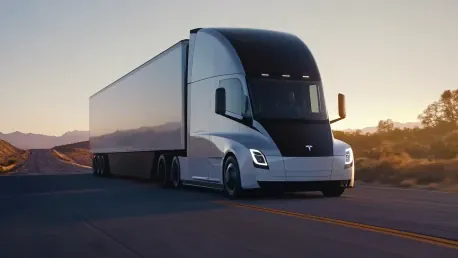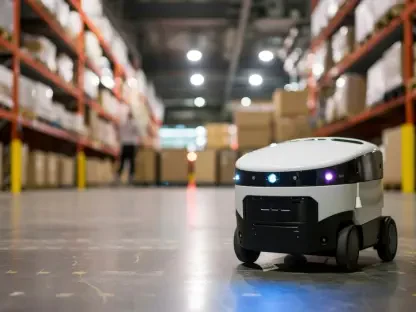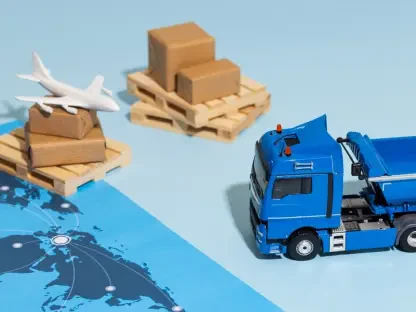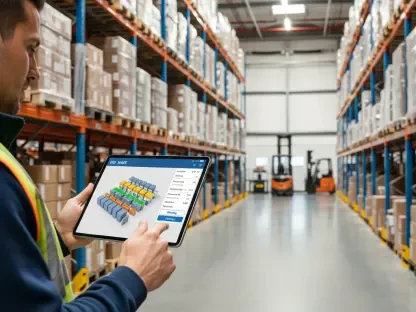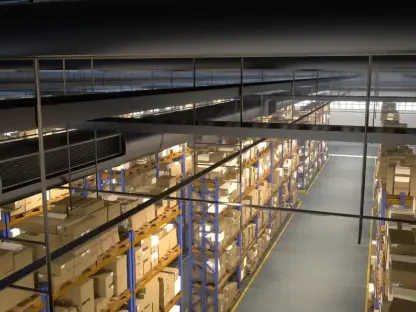The e-commerce boom has cast the spotlight on last-mile delivery, where the package arrives at the consumer’s doorstep. This critical step in logistics is fraught with challenges, from rising shipping costs to heightened consumer expectations for quick delivery. Companies are revolutionizing their strategies by integrating advanced technologies to overcome these hurdles and thrive in the competitive market landscape.
Rising Shipping Costs: A Pressing Challenge
Impact of Shipping Rate Hikes
Rising shipping rates, such as the USPS rate hikes of up to 9.2%, have pressured retailers to rethink their delivery strategies. These rate hikes represent a significant cost increase for businesses relying on national carriers. Absorbing these increased costs is unsustainable for most businesses, pushing them towards exploring innovative methods to stay competitive while maintaining high levels of customer satisfaction. Companies face a crucial decision: either pass these additional costs onto the consumer, potentially risking customer dissatisfaction, or absorb the costs to retain competitive pricing, which threatens long-term profitability.
The impact of rising shipping costs is not isolated to just the financial aspect. It extends to how businesses design their logistics and fulfillment strategies. Many retailers have been subsidizing free delivery to meet consumer expectations, but this approach is becoming increasingly unsustainable. Companies need to balance providing attractive delivery options with maintaining their financial health. By innovating their fulfillment models, companies are striving to find a middle ground where they can offer cost-effective delivery options without compromising on speed or service quality.
Hybrid Fulfillment Models and Micro-Fulfillment Centers
To mitigate high shipping costs, businesses are adopting hybrid fulfillment models that use both national carriers and localized delivery networks. This dual approach allows companies to optimize each segment of the delivery process, utilizing national carriers for long-haul transportation and local networks for last-mile deliveries. By integrating these systems, businesses can reduce reliance on expensive long-haul shipping and focus on cost-effective local deliveries. This strategy not only lowers shipping expenses but also enhances delivery speed and reliability.
Additionally, developing micro-fulfillment centers closer to consumers helps reduce long-haul transportation costs and delivery times. Micro-fulfillment centers are small, strategically located warehouses that store high-demand products closer to urban areas. This approach minimizes the distance between the fulfillment center and the customer, thereby reducing both delivery times and associated costs. Micro-fulfillment centers leverage automation and advanced inventory management systems to ensure optimal stock levels, further enhancing efficiency. These facilities play a crucial role in supporting same-day or next-day delivery promises, which are increasingly expected by consumers in the competitive e-commerce market.
Leveraging Technology for Efficiency
AI and Predictive Logistics
Businesses are turning to Artificial Intelligence (AI) to optimize delivery routes in real-time, consolidate smaller deliveries, and dynamically assign orders to the most efficient carriers. AI-powered algorithms analyze vast amounts of data, including traffic patterns, weather conditions, and historical delivery times, to determine the most efficient routes for delivery vehicles. This capability allows for dynamic routing adjustments, reducing travel time and fuel consumption. By consolidating smaller deliveries into larger ones, companies can maximize the use of their delivery fleets, minimizing unnecessary trips and associated costs.
Furthermore, predictive logistics powered by AI enables businesses to anticipate potential disruptions and proactively plan around them. For instance, AI can predict delivery delays due to traffic congestion or adverse weather conditions, allowing companies to adjust delivery schedules and inform customers in advance. This proactive approach not only improves delivery reliability but also enhances customer satisfaction by providing transparency and accurate delivery estimates. AI’s role in predictive logistics extends to inventory management as well, predicting demand patterns and ensuring optimal stock levels at fulfillment centers to meet consumer demand efficiently.
Automation and Smart Warehousing
Automation and robotics in warehousing streamline the picking, sorting, and managing of goods, increasing efficiency in last-mile delivery. Automated systems such as robotic picking arms and conveyor belts significantly reduce the time and labor required to process orders. These systems operate with high precision and speed, ensuring accurate and timely order fulfillment. Smart warehousing technologies integrate various automation tools to create a seamless, efficient workflow from the moment an order is received to its dispatch for delivery. This level of automation is vital for handling the growing volumes of shipments driven by the e-commerce boom.
In addition to enhancing operational efficiency, automation in warehousing also improves inventory management by providing real-time visibility into stock levels and movement. Smart warehousing systems use sensors and AI to track inventory, identify low stock levels, and automate reordering processes. This ensures that popular products are always available for quick dispatch, reducing the risk of stockouts and enhancing customer satisfaction. The integration of automation and smart technologies in warehousing is a key enabler for businesses striving to meet consumer expectations for fast and reliable deliveries in a competitive market.
Managing Delivery Networks Complexity
Unpredictability and Delivery Density
The unpredictability of package volumes and delivery locations requires creative solutions. Businesses often face fluctuating package volumes due to seasonal trends, promotional events, and changing consumer behaviors. This unpredictability challenges the capacity planning and resource allocation of delivery networks. To address these challenges, companies are focusing on improving delivery density – the number of deliveries made within a specific geographic area. By bundling more deliveries together, businesses can maximize the efficiency of their delivery routes, reducing operational costs and environmental impact.
Additionally, optimizing delivery density involves analyzing delivery data to identify patterns and trends. Machine learning algorithms can predict peak delivery times and high-demand areas, allowing companies to deploy resources where they are needed most. This strategic approach ensures that delivery vehicles operate at full capacity, minimizing empty miles and enhancing overall efficiency. Balancing same-day or next-day delivery expectations with budget constraints remains a substantial hurdle. To overcome this, companies are investing in advanced route planning and optimization tools that account for real-time variables and dynamically adjust delivery schedules to meet customer demands while controlling costs.
Cross-Docking and Diverse Deliveries
Innovative strategies, such as cross-docking facilities closer to end consumers, help consolidate shipments, reducing transit times and expenses. Cross-docking involves transferring goods directly from incoming transportation to outgoing delivery vehicles with minimal or no storage time in between. This method significantly reduces the handling time and storage costs associated with traditional warehousing. By positioning cross-docking facilities near urban centers, businesses can expedite the last-mile delivery process, ensuring that products reach customers faster and more cost-effectively. This strategy is particularly beneficial for time-sensitive deliveries and high-demand products.
Accommodating the delivery of both lightweight and bulky items presents additional complexities that need flexible and cost-effective solutions. Traditional freight models often struggle to manage the diverse delivery requirements of e-commerce, where orders can range from small packages to large household appliances. To address this, companies are exploring hybrid delivery models that combine different transportation modes and vehicle types. For example, utilizing smaller vehicles for last-mile deliveries in congested urban areas and larger trucks for transporting bulky items over longer distances. This flexible approach ensures that various delivery needs are met efficiently, without compromising on service quality or cost-effectiveness.
Emphasis on Transparency and Delivery Options
Consumer Expectations and Cart Abandonment
Providing clear delivery options and estimated delivery dates is crucial, as demonstrated by a Baymard Institute report showing that 41% of e-commerce sites lack this information, leading to increased cart abandonment rates. Consumers today expect a seamless shopping experience, and transparency in delivery options is a key component of this experience. When customers are uncertain about delivery times, it creates a barrier to completing the purchase. Retailers that fail to provide accurate delivery estimates risk losing potential sales and damaging their reputation. Clear communication of delivery options reassures customers, enhancing their confidence in the purchase process.
Retailers can leverage technology to provide real-time delivery tracking and updates, further enhancing transparency. Implementing features such as real-time order tracking, delivery notifications, and estimated time of arrival (ETA) can significantly improve the customer experience. These tools empower consumers with the information they need to make informed decisions and plan for delivery. By integrating these technologies, businesses can reduce cart abandonment rates and increase customer satisfaction and loyalty. Offering multiple delivery options, including standard, expedited, and same-day delivery, caters to diverse customer preferences and enhances the overall shopping experience.
Benefits of Same-Day Delivery
Offering same-day delivery can drive revenue growth, with Roadie survey findings indicating that 80% of businesses with this option see increased sales and 77% report gaining new customers. The convenience and immediacy of same-day delivery appeal to consumers who value quick access to their purchases. This competitive edge can attract new customers and encourage repeat business. Same-day delivery is particularly advantageous for urban centers, where the dense population and proximity to fulfillment centers make rapid deliveries feasible. Retailers that successfully implement same-day delivery gain a significant advantage in customer acquisition and retention.
Transparency and flexibility in delivery options directly contribute to consumer satisfaction and business success. Providing accurate delivery estimates and offering various delivery choices allow customers to select the option that best suits their needs. This flexibility is especially important in today’s diverse consumer landscape, where preferences and expectations vary widely. Retailers that prioritize transparency and flexibility in their delivery processes are more likely to build trust and loyalty with their customers. As e-commerce continues to grow, the importance of these factors will only increase, making them critical components of a successful logistics strategy.
Adapting to a Competitive Market
Harnessing Advanced Logistics Technology
The competitive e-commerce market, projected to reach $5.5 trillion by 2027, necessitates the integration of advanced logistics technologies. As online shopping continues to expand, businesses must adopt cutting-edge solutions to manage the increasing volume of orders efficiently. AI for route optimization, automated dispatch systems, and smart warehousing are essential for managing growing volumes and ensuring delivery accuracy and efficiency. These technologies streamline operations, reduce costs, and enhance service quality, positioning businesses to thrive in a rapidly evolving market.
Machine learning algorithms play a crucial role in predicting demand and optimizing inventory levels, ensuring that popular products are readily available for quick dispatch. Automated dispatch systems facilitate the efficient allocation of orders to delivery vehicles, minimizing delays and enhancing delivery speed. Smart warehousing technologies, including robotics and IoT devices, improve the accuracy of order fulfillment and inventory management, reducing errors and increasing operational efficiency. By harnessing these advanced logistics technologies, businesses can meet the demands of modern consumers while maintaining a competitive edge in the e-commerce landscape.
Crowdsourced and Gig-Based Delivery
As e-commerce continues to grow, businesses increasingly turn to crowdsourced and gig-based delivery models to meet consumer demand. These models leverage independent contractors to handle deliveries, offering flexibility and scalability. Crowdsourced delivery platforms, such as UberEats and Postmates, have demonstrated how effectively gig workers can fulfill last-mile deliveries, especially in urban areas where quick turnaround times are critical.
This approach also allows businesses to handle fluctuations in delivery volume more efficiently. By tapping into a pool of gig workers, companies can quickly scale their delivery capabilities up or down based on demand. This flexibility is particularly beneficial during peak seasons or promotional events when delivery volumes spike. Moreover, incorporating gig workers reduces the need for maintaining a large fleet of delivery vehicles and staff, thereby lowering operational costs.
Crowdsourced and gig-based delivery models also offer consumers additional convenience and faster delivery options. Many of these platforms enable real-time tracking, giving customers visibility into their order status and estimated delivery times. This transparency enhances the overall customer experience, building trust and satisfaction. As these models become more popular, businesses that adopt and optimize crowdsourced and gig-based delivery can differentiate themselves in the competitive e-commerce market by offering reliable and rapid delivery services.
